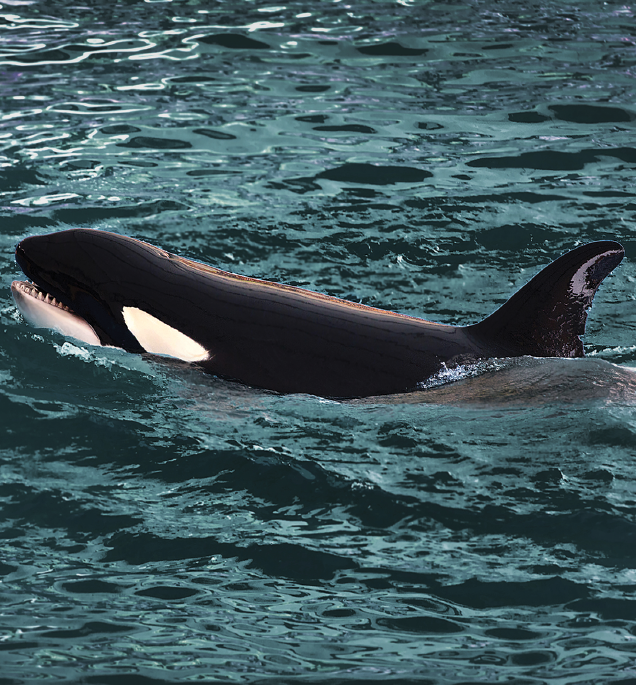Oregon’s secret visitors
written by Ethan Schowalter-Hay
Ocean cumulus forms skyline ramparts on a May morning at Rocky Creek State Scenic Viewpoint on the central Oregon coast. Breeze brings a rank spring cow-parsnip smell from nearby spruce woods. Sea lions hump north through the rollers aws pelicans wing low over distant swells.
Just past the breakers, comes a blast of breath, a puff of vapor. A tall black sword, wavering slightly, cuts the water. In its wake, a gleaming black prow tattooed with fierce white surfaces with another punch of steam, another slash of fin.
Orcas—four of them, muscle north with the regal confidence—swim quickly out of sight. Were they real?
Though the Oregon Coast isn’t as synonymous with orcas as the Salish Sea of western Washington and adjoining British Columbia, its cold gray waters are also part of their dominion.
Glimpsing an orca here may be hit or miss, the quest is well worth taking—not the least for the Oregon’s sublime seashores.
Whale Killers: The Transient Orcas of Spring
The best season for spying orcas along Oregon’s coast comes in late spring. That’s when so-called transient orcas arrive like clockwork to stalk the calves of gray whales journeying north alongshore to Alaskan waters.
Transient orcas are mammal-eaters, traveling in smaller groups than the better-known salmon-munching “resident” orcas of the Salish Sea. Residents and transients, as well as the more mysterious “offshore” killer whales, all appear to be genetically distinct. Some scientists speculate these whales may eventually be considered separate species.
Luke Parsons, a ranger with the Oregon Parks and Recreation Department’s Whale Watching Center in Depoe Bay notes the transient pods typically arrive between mid-April to May. Though they range widely, many sightings occur along the central coast, roughly between Florence and Lincoln City.
When whale calves prove elusive, transient orcas happily set their sights on Oregon’s resident pinnipeds—harbor seals and California and Steller sea lions. Pursuing such whiskered fare sometimes draws the killer whales right into coastal river mouths. A few years back, an ambitious orca chased a sea lion deep into the Yaquina Bay estuary, nearly to Toledo—a National Geographic-worthy spectacle witnessed by more than a few awed onlookers.
Sea lions have been seen abruptly hauling ashore en masse this time of year—perhaps because of prowling orcas nearby. “If you’re a seal or sea lion and you hear an orca, you’re going to get out of the pool,” Parsons said.
Recent years have also seen orcas straying up the Siuslaw River—at least to the Highway 101 bridge—and into Coos Bay.
These whale-hunting orcas typically don’t remain close to shore in Oregon waters for long, though some years they’ve loitered well into summer. In 2016, for instance, they were still cruising in June. A U.S. Coast Guard Sector North Bend helicopter photographed six orcas harassing a sea lion off of the shore of Florence that month, and a pod buzzed Depoe Bay as late as June 27.
Visitors From the North: The Southern Residents
The transients of spring aren’t the only orcas to occasionally grace our briny backyard. The Southern Resident killer whales (SRKWs) of the Salish Sea—the world’s most famous wild orcas—also periodically swing through. This is especially true in winter, when two SRKW groups, the L and K pods, leave their summer range—the inner waterways of Puget Sound, the Strait of Juan de Fuca, and the Strait of Georgia—and roam the outer coast as far south as central California.
The winter geography of the SRKWs was long something of a mystery, but lately scientists with the National Oceanic and Atmospheric Administration’s Northwest Fisheries Science Center have gathered valuable insight by using satellite transmitters to track the whales’ movements.
These studies have revealed an interesting pattern. In late winter and early spring, members of the K and L pods often frequent the mouth of the Columbia River. This time of year, spring Chinook salmon are bee-lining for these turbulent waters to make their spawning run upstream. The Southern Residents are there to greet (and eat) them before heading back to the Salish.
The River Whales: Orcas Up the Columbia
Among the more extraordinary aspects of the orca’s presence in Oregon is the whale’s occasional appearance in the Columbia River.
That orcas sometimes enter the lower Columbia Estuary isn’t all that surprising, given their salmon-chasing habits. Rarely, though, have killer whales been seen above the brackish reach of the estuary, marked roughly by Puget Island.
The best-known exception occurred in October 1931, when a young cow orca showed up in the Oregon Slough—also known as the North Portland Harbor, a southerly channel of the Columbia separated from the mainstem by Hayden and Tomahawk islands. This industrial North Portland waterfront, is 110 miles east of the Pacific.
The whale, nicknamed “Ethelbert,” became an instant celebrity. Because she spent her Oregon Slough residency between the railroad and Pacific Highway (now I-5) bridges, she wasn’t terribly hard to find, and hordes of Portlanders—perhaps 100,000 in all—turned out to see the local cetacean. A couple of enterprising fishermen offered Ethelbert-viewing cruises for a quarter.
Though many urged she be left alone or somehow herded out of the slough, others suspected she was starving and advocated her euthanasia. Ethelbert was to be “spared” execution by dynamite—the Humane Society’s recommended solution at the time—when two men harpooned Ethelbert to death.
A few orcas have been reported in the vicinity of the Rose City since Ethelbert’s demise, though not for many decades—once in 1940 and again in 1942.
Top Spots for Viewing Transients
Headlands or other oceanfront heights with long, wide views of the Pacific make prime whale-watching vantage points.
-Neahkahnie Mountain
-Cape Foulweather
-Cape Perpetua
-Cascade Head
-Boiler Bay
-Depoe Bay
-Yaquina Head
-Yaquina Bay Lighthouse
Top Spots for Viewing Residents
According to Brad Hanson of the Northwest Fisheries Science Center, whales are often found between the river mouth and Grays Harbor to the north.
-Lewis & Clark Interpretive Center
-Cape Disappointment Lighthouse
-North Head Lighthouse
Viewing Tips
+Take heed of the weather forecast. High overcast and low swells are ideal for looking for orcas.
+Binoculars are essential (some overlooks like the Whale Watching Center and the Cape Perpetua Visitor Center have optical aids on hand for public use). For initially locating orcas, however, the naked eye is your most dependable tool. Unfocus your gaze as you slowly scan the seas, watching for spouts, wakes or fins in your peripheral vision. If you think you see something, zero in with the binoculars.
Orcas in the Columbia (though well downstream of Portland) made news as recently as May 2010, when a motorist stopped for construction on the Washington side of the river not far west of Longview said he saw two surface about 25 feet offshore.
It’s hard to say what motivates sporadic “river orcas”—transients hunting seals and sea lions tracking fish runs upriver? Residents shadowing Chinook? Regardless, such forays must be brief. Brad Hanson of the Northwest Fisheries Science Center said that a killer whale would soon have skin problems in freshwater after a few days.
A Closing Orca-Watching Tip: The Value of Staying Put
During transient season, it’s tempting to hop from headland to headland, scanning briefly at each and then—convinced the whales are doing backflips just one cape over—dashing to the next. Instead, consider the more laid back (and often more productive) seawatch route. Stake out a well-situated vantage and stick to it for hall a day. Odds are you’ll still come up empty in the orca department, but you’re bound to see something interesting—keening oystercatchers perhaps, or a bald eagle soaring seaward, or a spouting gray whale.
Meanwhile the act of ocean-gazing—lulled by breakers and cloudscapes, ears full of wind—is bound to calm the pulse and clear the head. And maybe, just maybe—right about when the whole scene seems a waking dream—the seas will foam with a fly-by from those great black-and-white hunters.









